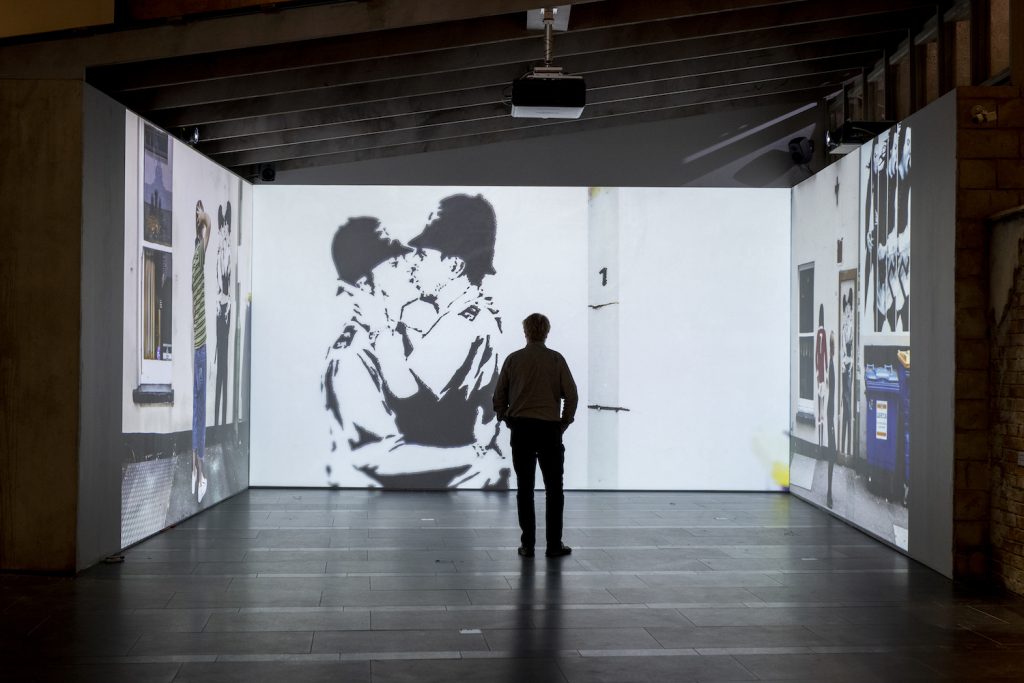
Banksy – a challenging relationship with museums
The relationship of Banksy, the world’s most famous street artist, with the art world has always been hostile. He is simply not interested in art institutions. Yet museums, galleries and art markets are all the more attracted to this mysterious artist, whose pranks are loved by viewers and whose works are sold for large sums. Banksy’s art will be seen in summer 2021 in Serlachius Museums’ exhibition Banksy. A Visual Protest.
In 2001, Banksy wrote in the manifesto of his first book that he is not bothered if the official art world does not recognise him. To his mind, writing graffiti is about the most honest way you can be an artist and bus stops are far more interesting and useful places to have art than museums.
Early in his career, the artist painted near the entrance to the Tate Modern a monkey blowing up the Mona Lisa. From 2003 to 2005, he played with the world’s most famous museums in London, Paris and New York, smuggling his own works into them.
Art auctions have received their share of his ridicule. The acclaimed Banksy sold a work entitled I Can’t Believe You Morons Actually Buy This Shit at an art auction for a high price. His most famous auction took place in London in 2018, when a work destroyed itself with a shredder installed within its frame immediately after it was sold.
For Banksy the elitist art world is a joke, where a small group of people define what is valuable. He is not interested in selling his works to galleries or museums or exhibiting them there. He believes in democratic street art that is freely and equally available to all people and that anyone can understand.
Part of the continuum of art history
Banksy’s relationship to the visual arts tradition is also multidimensional. His art has been examined in relation to earlier graffiti and street art, Dada, Surrealism, Situationism, Pop Art, popular culture, punk aesthetics, rap culture and various manifestations of Postmodernism.
Banksy himself plays with art history in works where he has painted his own themes on top of old paintings he acquired in flea markets or reproduced. By commenting on classical works and more recent art in this way, Banksy is ineluctably part of the historical continuum of the visual arts.
Visual art institutions have had their own difficulties perceiving Banksy’s importance, and the art world has been critical of him. This is no surprise. In art history, artists who have called into question and transformed practices and institutions have always had to wait to be accepted or taken seriously.
Banksy versus museums
Museums have also had to take a stand on Banksy, whose story is one of the most captivating phenomena in contemporary art. For Banksy himself, museums are not particularly interesting partners. Throughout his career, however, he has played a game of ironic hide-and-seek with museums and galleries.
The most notable exception to this rule occurred in 2009, when Banksy opened in his hometown an extensive exhibition, Banksy vs. Bristol Museum. He filled the very traditional museum with his own works, placing them not only in his own installations, but also among the museum’s collection. The result was the Bristol Museum’s most popular exhibition ever.
At the same time, Banksy challenged the museum’s curators to consider what the public expects from museums.Museum professionals began to see museum work as a way of combining creativity and playfulness with academic thinking. They even started to work in a new way themselves: Banksy’s intervention influenced the museum’s future exhibitions and strategies.
The case of Bristol is a rare one – Banksy has not very often exhibited his works in museums voluntarily. He has, however, participated in group exhibitions from time to time.
Banksy does not like museums or galleries opening exhibitions of his work independently. The phenomenon has grown worldwide, and the artist now warns about it on his website. Below the text are listed Banksy exhibitions held around the world and the prices of the admission tickets charged in connection with them.
For Banksy, this is a kind of consumer education. He wishes to disassociate himself from exhibitions in which he has not been involved with himself and whose main motive, he considers, is to make money for their organisers.Perhaps the reality that the exhibitions are never on the same level as those organised by Banksy himself is a contributing factor.
Exhibitions about Banksy, not Banksy exhibitions
Might Banksy today no longer be as hostile to museums as the 25-year-old novice artist who once wrote his manifesto criticising the art world? It is worth remembering that museums themselves have changed enormously along the way, much in the direction shown by Banksy himself.
Given the attitude of the artist, it makes most sense for museums to aim to hold exhibitions about Banksy, not exhibitions that try to be Banksy exhibitions. In any case, he himself creates his own exhibitions better than museums do: in addition to his creativity, he has at his disposal the best works of the moment.
It has been speculated that Banksy’s struggle against the art world is ultimately futile. The works of an economically actively artist will finally end up in museums. Perhaps Banksy himself has understood this. He has said about his own work:
“It’s nice to see it’s been so popular but it makes me a bit suspicious. Throughout history all the great artists have been overlooked in their own lifetime and only appreciated once they’ve gone. I’m starting to worry I’m not one of the good guys.”
Pauli Sivonen
Director of the Serlachius Museums
The text is a summary of an article written in the exhibition catalogue.

